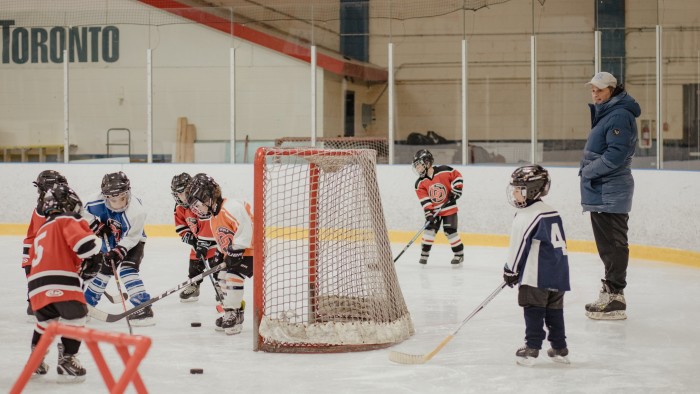Our Terms & Conditions | Our Privacy Policy
Young Canadians ditch ice hockey for football and basketball
Martin Ross had the most Canadian of dreams: to watch his two sons play ice hockey in their backyard in suburban Toronto.
But in what many see as a metaphor for the decline of the country’s national sport, his neighbours complained about the noise and city officials ordered the rink he built at a cost of C$300,000 (US$209,000) to be removed by the end of the year.
“I grew up on the ice. We skated before and after school. I wanted the same for my kids. To see their happiness, on the ice, I didn’t think of the cost, I cried tears of joy,” said Ross, in Markham on the outskirts of Toronto.
Hockey is more than a game in Canada; it’s a cultural phenomenon with roots in indigenous culture, and has shaped the nation’s identity and values for more than a century. Millions of children, including the sport’s Canadian icon Wayne Gretzky, learned to skate in their backyards or on neighbourhood rinks.
But the sport’s popularity has fallen away in recent years. Many blame the decline on the cost of equipment and the increasingly competitive nature of the game.
In 2022, 340,365 under-18s played hockey at a junior level, according to governing body Hockey Canada, down from 523,785 in 2009 — a 35 per cent drop. Although the numbers rebounded slightly in 2023 to 360,031, they remain 15 per cent below pre-pandemic levels.
South of the border in the US, youth participation has steadily increased over the same period.
Meanwhile, a 2023 survey by Solutions Research Group Consultants, a Toronto-based research company, found about 1mn young Canadians, or 16 per cent of all youth between the ages of three and 17, play organised football, or soccer.
‘Families are struggling to buy a house, so they can’t spend up to $10,000 a year on hockey,’ says Martin Ross © Chloe Ellingson/FT
Ed Kinnaly, chief executive of Bauer, a leading hockey equipment company, said Canada used to be his company’s biggest market but the US has overtaken it in recent years. “It’s a concern,” he said.
Kinnaly added the cost of kit and equipment had increased too. “In my day you bought a new wooden stick when it broke or new gloves when they wore out. Now kids want to replace it with what the pros use or the latest carbon-fibre release,” he said.
A Royal Bank of Canada survey earlier this year found that on average, young players’ parents spend C$4,478 on hockey each year — a total of C$53,735 by the time their child reaches 16 — underscoring the financial commitment the sport requires.
Ross, who coaches two junior teams and runs a youth coaching clinic with ex-NHL players, agreed hockey was an expensive undertaking.
“Families are struggling to buy a house, so they can’t spend up to $10,000 a year on hockey. Basketball and soccer are just so much cheaper and easier,” he said.
 Wayne Gretzky, centre, plays hockey with the local community in Sault Ste. Marie in 1978 © Lane Stewart/Sports Illustrated/Getty Images
Wayne Gretzky, centre, plays hockey with the local community in Sault Ste. Marie in 1978 © Lane Stewart/Sports Illustrated/Getty Images
Investment by local and federal authorities has also shifted to other sports. In 2019 the province of Ontario, home to 16mn people, announced plans to spend C$2bn over the next two decades on 45 new football fields, 30 basketball courts, 18 indoor pools and one single hockey rink.
Warmer weather because of climate change is affecting access to the country’s public outdoor ice rinks. The decline is being monitored by Wilfrid Laurier University in a project called RinkWatch, which described the winter of 2023-2024 as one of “the most challenging and unusual”. It said in its annual report that many rinks in southern Ontario, Atlantic Canada and in north-eastern US failed to open, while rinks in western North America experienced shorter skating seasons than usual.
Jack Jedwab, who runs the Association for Canadian Studies, a Montreal-based think-tank, said hockey was going through an “evolution not a crisis”.
“Hockey has been the dominant sport in Canada over 100 years but due to ongoing demographic shifts and the costs involved, you are seeing changes,” he said.
 Skaters use the newly refurbished Gage Park skating rink in Brampton, Ontario © Mike Campbell/NurPhoto/Getty Images
Skaters use the newly refurbished Gage Park skating rink in Brampton, Ontario © Mike Campbell/NurPhoto/Getty Images
The decline has not been helped by a scandal over allegations of sexual misconduct by Canadian Hockey League players and historic abuse by coaches that engulfed Hockey Canada in 2022.
The admission that millions were taken from registration fees to settle abuse claims caused outrage and prompted Ottawa to cut its funding and sponsors to sever ties with Hockey Canada.
The organisation published an apology in an open letter promising to “end the culture of toxic behaviour within our game”. It also appointed its first female head, Katherine Henderson, in 2023.
Hockey Canada declined to be interviewed but a spokesperson Spencer Sharkey said the group was “extremely encouraged” by the small post-Covid increase in player numbers.
He added the organisation had launched a number of initiatives, including funding assistance, to make the sport more affordable and inclusive, adding there were “a record number of women and girls (now) playing the sport”.
But for Ross, who is contemplating the removal of his beloved hockey rink, passion for the sport needs to be rekindled.
“This whole saga with my rink sums up why hockey is in demise,” he said. “Would we have Wayne Gretzky today, if Walter Gretzky didn’t build the backyard rink that he built for his son?”
Images are for reference only.Images and contents gathered automatic from google or 3rd party sources.All rights on the images and contents are with their legal original owners.



Comments are closed.